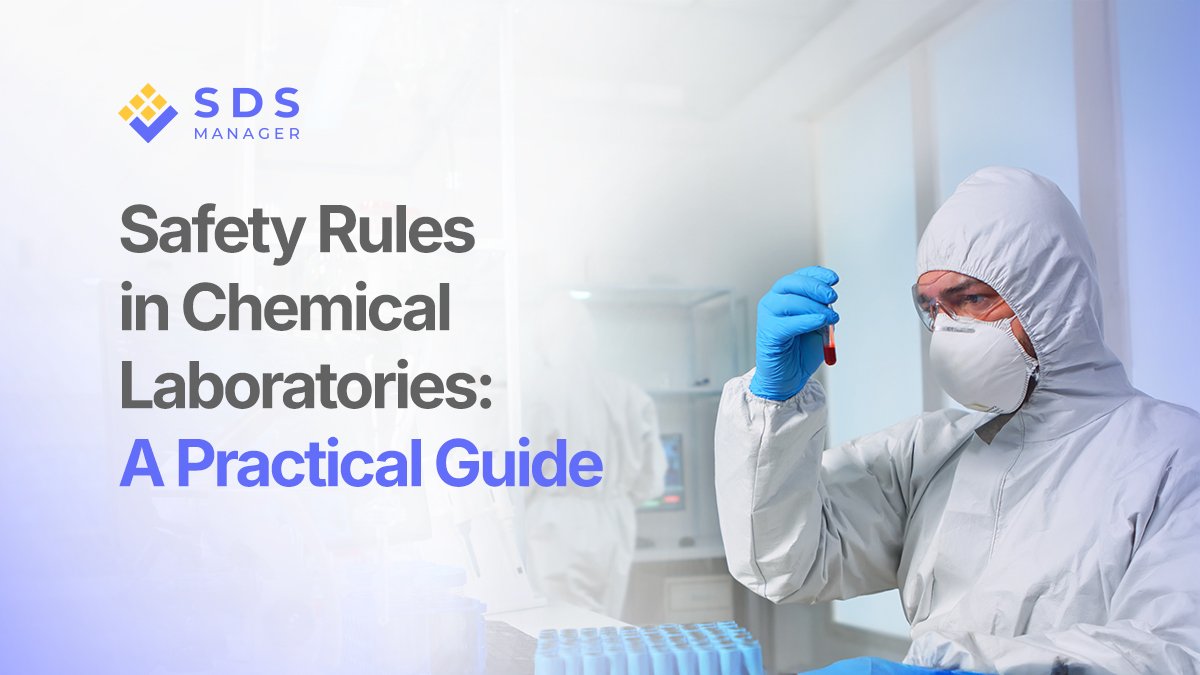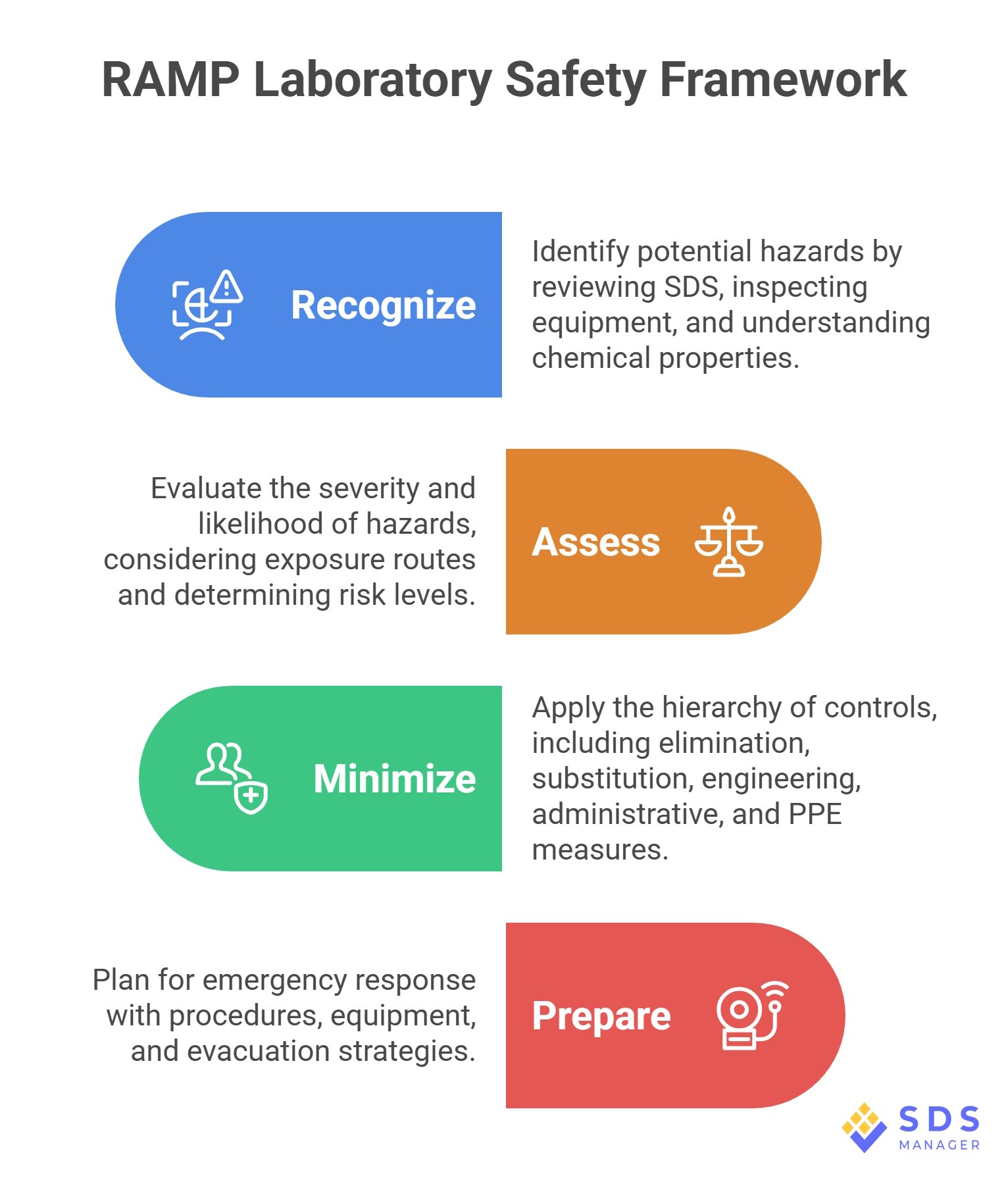

Safety in a chemical laboratory means following proven rules and using the right equipment to keep everyone protected from chemical accidents, spills, and fires.
It’s about knowing the hazards of every substance you work with, storing and handling chemicals correctly, and wearing proper protective gear. Strong lab safety practices protect health, prevent costly incidents, and keep the lab running smoothly.
In this article, we will walk you through the necessary safety steps aligned with global laws such as GHS (labels and SDS), and effective PPE usage to keep your laboratory safe.
Lab safety rules that must be followed
1) Plan the task before handling chemicals
Before beginning the process of handling chemicals, apply RAMP:

2) Ensure hazard communication for every container
Make sure anyone who might use the material can identify it and understand the risks. Use clear labels with names and hazard information on all working and storage containers. Keep SDS easy to access in digital or print form. These help in understanding the hazards and risks associated with each material.
3) Store and handle by compatibility
Avoid storing incompatible chemicals together.
- Keep acids separate from bases
- Store oxidisers away from organics
- Keep water-reactives clear of aqueous substances
Use secondary containment (such as spill trays) for liquids, and follow your lab’s chemical storage plan rather than alphabetised shelving.
4) Use engineering controls correctly
If vapors or aerosols can form while handling a chemical, move the task to a chemical fume hood.
- Work at least 6 inches inside the sash
- Raise large apparatus by 2 inches to maintain airflow
- Never store chemicals in the hood
- Close the sash when unattended
5) Be ready for emergencies
In case lab personnel are affected by chemical spills in the eye, first aid involves knowing the route to the eyewash and safety shower.
After a splash, flush with lukewarm water for 15 minutes, then seek medical care and report the incident.
6) Manage waste and housekeeping
- Label chemical waste containers and keep them securely closed
- Avoid mixing incompatible waste streams
- Keep exits and access to emergency gear clear
- Clean work surfaces and log any safety concerns at the end of each shift
Prudent Practices provides detailed checklists you can adapt.
7) Keep improving with a management system
Build your lab’s routine around a simple safety management cycle. ISO 45001 is a widely used, global framework for finding hazards, setting controls, and reviewing performance.
PPE in chemical labs: what each item does and when to use it
PPE is your last line of defense after elimination, substitution, and engineering or administrative controls. Choose PPE based on the chemical, the task, and the exposure route, and verify standards or markings where applicable.
Tip: Glove choice depends on permeation and breakthrough time. Always check the SDS and the glove maker’s chart, not just the material name.
PPE requirements and significance
| PPE item | What it protects you from | When to use it (simple examples) | How to use it correctly | Common mistakes to avoid |
|---|---|---|---|---|
| Safety glasses | Eye impacts, small splashes, and debris | Setting up apparatus, handling sealed containers, weighing powders; general bench tasks with low splash risk | Use side shields or wraparound frames; lenses should be clean and scratch-free; fit so coverage stays over the eyes | Wearing above eyebrows or low on the nose; no side protection; scratched lenses that reduce visibility |
| Splash goggles | Liquid splashes and mists that can reach the eyes; light vapor irritation | Diluting acids or bases, transferring solvents, washing glassware | Ensure a full face seal; indirect vents are recommended for liquid work; strap snug, not tight | Swapping goggles for glasses during wet work; lifting goggles mid-task |
| Face shield (over goggles) | Large splashes, sudden releases, and flying fragments to the face and neck | Large volume transfers, pressurised containers, reactive mixes | Always wear over goggles; shield extends from chin to forehead; ensure full chin-to-forehead coverage | Using a shield instead of goggles for chemicals; cloudy/shabby shields that obscure vision |
| Chemical-resistant gloves (nitrile, neoprene, butyl, etc.) | Skin contact and chemical soak-through from solvents, corrosives, and sensitizers | Handling liquids, cleaning, waste transfer, wiping spills | Choose gloves based on chemical compatibility and replace before breakthrough; change on a schedule; remove inside-out | Choosing only by material name or thickness; wearing past breakthrough time; rinsing disposable gloves with solvents |
| Lab coat | Splashes to the torso and arms; reduced flame spread with FR coats | Everyday benchwork, minor heating, liquid transfer | Fully fasten front; sleeves to wrist; wear flame-resistant cotton near ignition sources | Rolled sleeves; open fronts; synthetic streetwear underneath that can melt |
| Chemical apron | Extra protection to chest and lap against corrosive or high-volume splashes | Acid/base baths, drum transfers, clean-up tasks | Wear over a lab coat; check chemical compatibility of apron material (confirm via SDS/supplier) | Using PVC with strong solvents where it degrades; loose/dangling straps |
| Closed-toe shoes / overshoes | Spills on feet, sharp edges, and broken glass | Any lab activity involving liquids or glass | Wear enclosed, sturdy shoes; use overshoes for high splash risk | Open shoes; mesh/knit or absorbent fabrics in spill areas |
| Respirator (task-specific; last resort) | Breathing in harmful vapors, gases, or aerosols when other controls fall short | When local exhaust isn’t sufficient (e.g., emergency clean-up) | Use only within a written programme; must include fit testing and proper filter selection according to hazard | Wearing one without fit testing; wrong cartridge; relying on a respirator instead of fixing ventilation |
Also know your chemical lab safety equipment locations: eyewash, shower, extinguishers, alarms, spill kit, and gas shut‑offs. Practice reaching them with eyes closed.
Final Thoughts
This checklist guides how regulators and professional bodies expect labs to run:
Clear hazard communication, risk‑based controls and good engineering practice at the bench, trained use of emergency equipment, and PPE chosen by data, not guesswork.
Keep these parts in sync, and your chemical safety rules in laboratory practice will be strong, simple, and repeatable.
FAQs
What is the quickest way to assess risk before an experiment?
Run a quick RAMP check and read the SDS; confirm ventilation, PPE, and compatibility.
Why “add acid to water”?
It reduces heat and splash risk during dilution. Do it in a hood and wear splash protection.
How do I know which glove to use for a solvent mix?
Check your institution’s glove guide and the manufacturer’s compatibility database; when in doubt, choose a higher-resistance material or double-glove.
How often should eyewashes be checked?
Most programs follow ANSI Z358.1: quick weekly activation and annual inspections.
Do safety glasses replace goggles?
No. Glasses are for impact. For liquids, use splash goggles; add a face shield for high splash.
What is “secondary containment”?
A tray or bin that can hold leaks from the primary container. Use it for acids, bases, and solvents, and separate incompatibles.